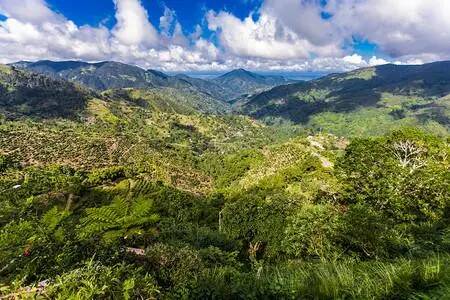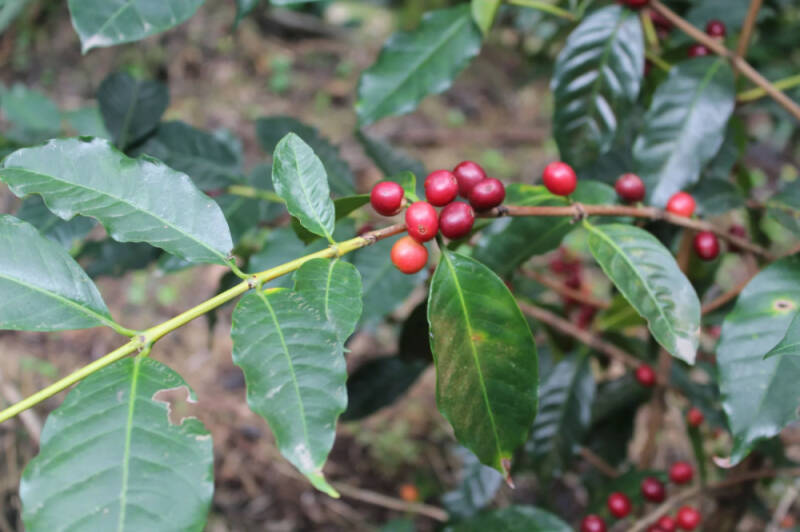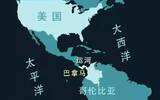Introduction of Jamaican Coffee Development, Blue Mountain Coffee and Jamaica Blue Mountain No.1 Coffee
Yamai plus an island country in the Caribbean is the third largest island in the Caribbean. The coastal areas of Jamaica are plains, with hills and limestone plateaus in the central and west, mountains in the east, and the Blue Mountains in the east. Jamaica has a tropical rainforest climate, with a rainy season from May to June and September to November each year, with an annual average temperature of 27 ℃. The climate and environment of the Blue Mountains, which are 1000-1700 meters above sea level, volcanic soil, rainy and foggy all the year round, make the coffee produced in the Blue Mountains of Jamaica famous in the world and create one of the most expensive coffee in the world.

History of Jamaican Coffee
In 1728, during the British colonial period, Sir Nicholas Lawes received a gift from the Governor of Martinique (now France), a coffee sapling, so the history of coffee on the island began. Coffee was originally grown in St. Andrews in southeastern Jamaica, but the production was very limited. By the late 18th century, coffee cultivation also spread from St. Anru to the Blue Mountains. In 1800, there were 686 coffee plantations on the island.

But in 1838, the abolition of slavery was really implemented, so there was a shortage of manpower on the plantation. Coupled with mismanagement and the loss of British preferential terms of trade with the colonies, the coffee industry began to decline, leaving only 180 coffee plantations by the 19th century. But the quality of cultivation was poor at that time, so in 1891 the government passed a decree to teach producers the knowledge of coffee cultivation and improve the infrastructure in order to improve the quality. After that, the Central Coffee Coffee Clearing House was established in 1944, and all exported coffee must be approved by the institution. In addition, the Jamaica Coffee Industry Association was established in 1950, but merged with other Jamaican commercial organizations in 2018 to form the Jamaica Agricultural Commodities Authority, referred to as JACRA. When it was founded, it also promulgated the Coffee Industry Supervision Act to delineate the "Blue Mountain Coffee growing area", so now every barrel of Blue Mountain coffee beans must be regulated through JACRA.
The definition of Blue Mountain Coffee
According to the Coffee Industry Supervision Law, the Blue Mountain planting area is distributed in four areas: St.Andrew, St.Thomas, Portland and St.Mary. Only the coffee varieties grown in this area with an altitude of 915m-1700 m can be named Jamaican Blue Mountain Coffee (Jamaica Blue Mountain). Iron pickup has been introduced into Blue Mountain since the 18th century, and it is one of the oldest varieties of coffee, but it is no longer widely planted because of its weak physique and poor disease resistance. However, the iron pickup in the Blue Mountains can well adapt to the local climate and soil, and evolve a better disease resistance, these characteristics can not be separated from the Jamaican country to adhere to and carefully plant iron card varieties.
And Blue Mountain Coffee is the only coffee in the world that is exported in wooden barrels. One of the Jamaican Blue Mountains (No. 1, No. 2, No. 3, PB) and the Jamaican Alpine (Alpine Top, Alpine PB) can only be used, with specifications of 70 kg, 30 kg and 15 kg. Among them, the most advanced Lanshan No. 1 coffee must meet the specification of more than 17 mothers, the proportion of defective beans can not exceed 2%, and the moisture content is about 10-12.5%. Other grades of Jamaican coffee are exported in 60 kg gunny bags.
Front Street Coffee Clifton Manor Blue Mountain one Coffee Bean
Producing area: Lanshan producing area
Manor: Clifton Manor
Altitude: 1310 m
Variety: blue Mountain Iron pickup Typica
Treatment: washing treatment
Flavor: slightly citrus acid, nutty and chocolate flavors, silky and well balanced
The front street is the Blue Mountain No. 1 coffee produced by Clifton Farm, which is still the oldest coffee producer in Jamaica. Carrifton Farm began to grow and produce coffee as early as the mid-18th century. And the selected Blue Mountain Coffee uses water washing treatment, which can make Lanshan No. 1 coffee with clearer flavor, higher cleanliness and stable quality. The front street will be roasted moderately on the deep side, so that Blue Mountain No. 1 coffee can show a mellow feeling and retain soft acidity. A KONO filter cup will be used in the front street and brewed at 1:15 proportion, you can smell the light fragrance of the flowers, the entrance will feel a slight citrus acid, with nutty and cocoa flavors, the taste is silky and well balanced.
Important Notice :
前街咖啡 FrontStreet Coffee has moved to new addredd:
FrontStreet Coffee Address: 315,Donghua East Road,GuangZhou
Tel:020 38364473
- Prev

Use of coffee cultivation in the Panama Canal area to help cure the effects of deforestation and drought
Recently, in the Kapila district of western Panama, an incentive program for coffee farmers to plant dozens of tree species near the Panama Canal has been launched to benefit key global waterways, Reuters reported. the recent severe drought on the Panama Canal has affected trade flows. And the drought continues.
- Next

How to make the powder bed of siphon pot coffee form a "hill"? How to use the siphon kettle? What are the extraction parameters?
When surfing the Internet in Qianjie, you can always see such a sentence: at the end of making siphon coffee (siphon pot coffee), if there is a small hilly pink bed, it means that this cup of coffee will taste better. But often, the powder bed after cooking is in a "plain" state, so many friends will be in the front street.
Related
- What effect does Italian American coffee with filter paper have? Will coffee taste better if it is put on filter paper at the bottom of the powder bowl?
- What is the color difference in coffee beans? What are the characteristics of honey processed coffee beans? Why are the anaerobically treated coffee beans uneven in color?
- How does novice Xiaobai quickly get started and make coffee? Newbies learn to make coffee by hand and share the specific steps and process process!
- Costa tea has a shelf life of 100 years?! Expert: Unable to verify
- It's a huge uproar! American milk addition was rejected by Manner employees?!
- Mocha pot coffee bean recommendations| How fine and how much powder should be used for grinding? What parameter ratios do I need to use to make milk with Mocha pot coffee?
- What are the characteristics of the world's top ten coffee beans treated with Costa Rica honey? How to make black honey kadura from Tarazhu Pilon Processing Plant taste good?
- How to make deep-roasted coffee? What grinding water temperature does authentic Jamaica Blue Mountain No. 1 coffee use to brew it well?
- Selected high-grade rose summer coffee flavor tasting guide Why Panama rose summer has the aroma of flowers and fruits
- What equipment does a novice Xiaobai need to buy to learn to make coffee? Filter cup electronic scale bean grinder manual flushing pot purchase guide

